
I remember my first impression of Paia as clearly as if it had been made yesterday. Arriving fresh from the Capital District of New York State,
Paia was a vision of paradise. Considerably dilapidated, and nearly devoid of tourists, it was the breath of fresh air that an East Coast escapee needs.
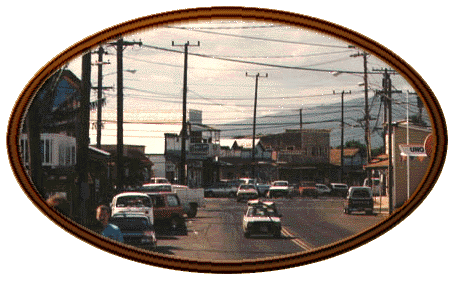
Downtown Paia (circa 1986).
Please don't get me wrong, there were open businesses in Paia. You could buy gas at one of the seven (!!) gas stations, or eat a variety of styles of food
in a number of small restaurants. You could shop at the funky health food store, and even buy a bag of pot (under the counter - somewhere in town). There
was a music store, a fish market (a real one - it sold fish, not fish sandwiches), a Zen tea house, and a TV repair shop. But you couldn't buy a pair of sunglasses or a tee-shirt
anywhere in town.

CLICK ON THE SMALL IMAGES TO VIEW ENLARGEMENTS.



I remember how lazy the town was. I distinctly recall dogs sleeping all day on the yellow lines in the middle of both the Hana Highway and Baldwin Avenue. And I
also remember the hippies. Not the new breed, lost without the "Dead" tour. The real hippies. The ones that came to Maui in the seventies, and disappeared
into the woods in Huelo and elsewhere.
Every morning, dozens of them would descend on the town like a flock of colorful birds, and roost in an abandoned and gutted building (120 Hana Hwy), where they studied
Astanga Yoga with the Master. It was astounding! I saw it. I know. I was the carrot juicer at the funky health food store across the street. Two days a
week squeezing carrots earned enough money to get by.
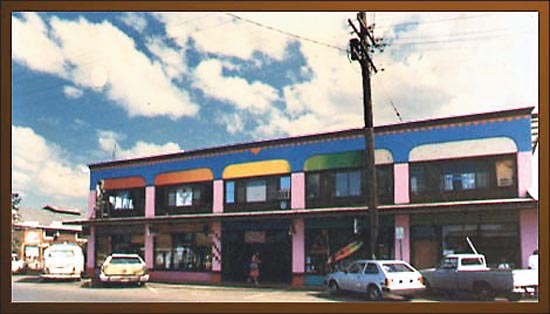
A year or so after the 120 Hana Highway (originally the Paia Mercantile)
was renovated, it was also repainted, by Kenmarc. If you look closely,
that's him painting outside his studio.
Our house was an old plantation style shack with three bedrooms, located oceanfront. The backyard ended at the cliff, and below, the ocean surged in and
out. When there was surf, we could watch kids surfing from the kitchen window. And the accessible local beach was less than 150 feet away.
I hate to tell you how little it cost us to live there. Sure, it was old, and decayed. You couldn't swat a mosquito with a magazine without damaging the
walls, but for $175 a month, split five ways (!), you couldn't complain. We could nude sunbathe on the roof, garden in the yard, and hear the Buddhist
temple bell in the morning and evening.
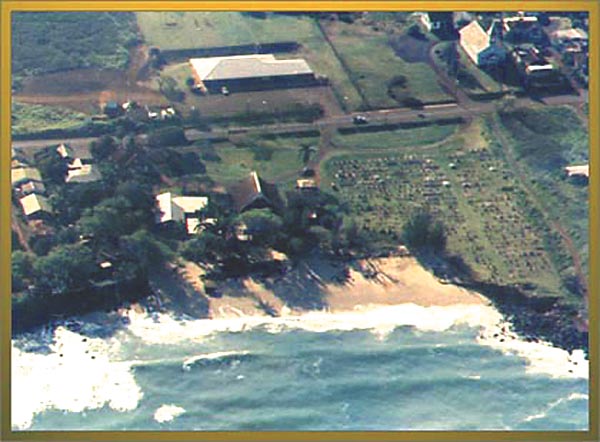
The Mantokuji Mission with its cemetery and beach as seen from above.
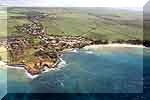

Of course, you can still hear the bell rung mornings and evenings, and every summer, around the first week of July, the Mantokuji Mission hosts its
annual "Bon" festival, honoring the ancestors. Everybody is welcome there, and from the crowds that it draws, it appears that everyone attends. The
"Bon" dance at the Paia Mantokuji Mission is actually nicer than the "Bon" dances held elsewhere on Maui. The live drummers, the brightly kimonoed
attendees, and the lovely setting, right on the ocean, make their "Bon" dance the best one.
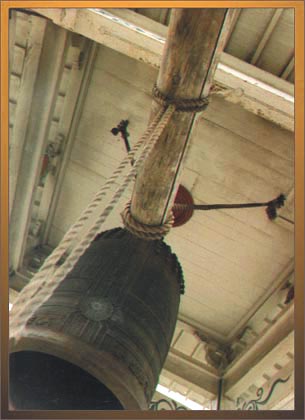
The giant bronze bell of Paia's
Mantokuji Mission.A LARGER IMAGE IS AVAILABLE: 504 X 729 PIXELS - 97K
A wonderful spectacle that more and more people will eventually experience for themselves. New houses are being built across the highway from the
temple. New residents will be awakened by the deep sonorous tones of the 5:30 AM (!) ringing of the mission bell.
Paia, in fact, has lots of different churches and congregations. There are a variety of Christian denominations, and even a resident Lama, where the
"House of Tea" was formerly located.
The tea house, unfortunately, isn't around anymore. It ended with the passing of its host, a shy and gentle
woman named Pat, who would perform the traditional Japanese tea ceremony for you for a small donation, or no donation at all. Her teahouse was an
austere but charming little cottage with a delicate little garden that welcomed you into its serene atmosphere. Honestly, I haven't thought of Pat
in a long time, and the writing of this paragraph has brought her back into my mind and heart in the fullness of her gentle ways.




Paia has seen more than a few business come and go. Whole buildings are gone. In the enlargement of the images above are several buildings that
no longer grace Paia's streets. The image in the center actually shows two buildings that are gone. The one on fire is the building that housed
"360" a very "relaxed" flop house that, over the years, provided a home to hundreds of new and used residents. Next door to it in the photo is one
of the seven gas stations that Paia had. Its fire was a few years before the "360" fire. But the second fire doomed it as well, and soon after, both
buildings were converted to landfill.
But, "360" wasn't the only business in that building. At the time that "360" was in operation, the front of the
building was occupied by a "French" restaurant, La Vie en Rose. I put quotes around French, because if you asked the owners, Michel and Manu,
they would tell you they are Basque, but to most people it was a French restaurant. It was charming and the food and cakes were delicious. But like
all small restaurants, it was too much work for just the two guys, so it eventually folded.
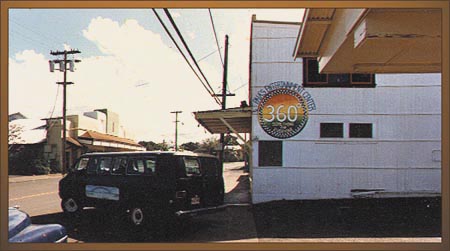
The "360" sign painted by Kenmarc in 1984.
And, "360" wasn't always there. When I moved to Paia, that building housed "Bob's H.O.", short for Hang Out, home of "da famous teriyaki
burger". I never ate there, but I did eat at Hew's Restaurant and Hats restaurant, both on Hana Highway. Hew's closed a long time ago, and
no other business has ever opened there. Hew's was an experience. They made the best saimin, and fried egg sandwich. They were open for
the early half of the day, closed after lunch. Anytime you went in and walked to the back, you could see a half-dozen or more older local
ladies hustling about, working around huge stock pots in a kitchen that - well, let's just say it wasn't Martha Stewart's. But, you could
rely on these busy ladies to make "good grub".



Hats Restaurant, so-called because the walls were ringed with hats, stood on the corner of Hana Highway and Baldwin Avenue and served good
ol' diner food at good ol' diner prices. Dorothy made a variety of American-style dishes, with a somewhat Hawaiian flair. She also
baked typical diner-style desserts and pastries. Me? I liked the little pecan-pie tarts. "Hats" was open all day - breakfast, lunch,
and dinner, and was always full of people.
In fact, the only place that didn't seem full of people was the town itself. But that was to change. Sometime in the early 80's the word got out that
Maui was a good place to windsurf. And by 1984, the summer season saw the arrival of a good number of European tourists. I remember one couple in particular,
who operated a wine shop during the ski season in Switzerland, and then came to Maui to windsurf. It made me think that there something extraordinary going on.
If people were willing to travel 11,000 miles to windsurf at Kanaha, then the word was out.
I began work on a drawing of the town which would proclaim to all that Paia was the "Windsurfing Capital of the World". This design eventually became the town's
official tee-shirt, and went on sale, in the fall, at the 1984 O'Neill Invitational. Paia would have to rub the sleep from it's eyes and awaken to its new role in the
watersports world.
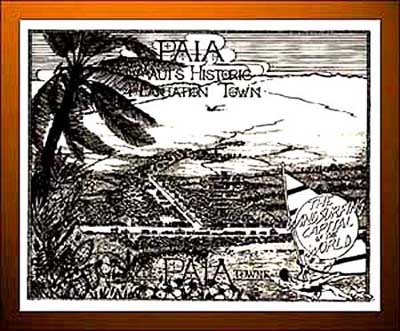
The "official" Paia tee-shirt, c. 1984
And that's what Paia did. New stores emerged; tee-shirts and bikinis became abundant on their racks. Once there were more than a half dozen
gas stations, now there were gift shops and galleries, and tourists walked the sidewalks of Paia, instead of driving through the town on their way
to Hana. Paia repaired and repainted its worn out facades.
The intersection of Baldwin Avenue and Hana Highway became so congested that
eventually a traffic light was installed. You know your town's alive when it gets a stop light. Supposedly traffic flows more smoothly, now.
But, don't tell that to the people backed up toward Kahului for two miles during the afternoon rush hour! Gridlock has come to the north shore of Maui.
And so, while Paia is considerably busier than the near-ghost town I first encountered, it is still, like Maui itself, NO KA OI - the best!
|
